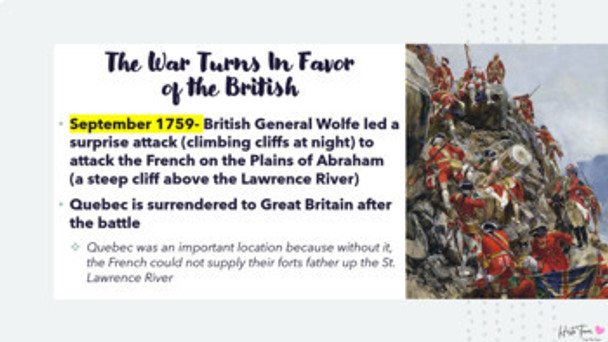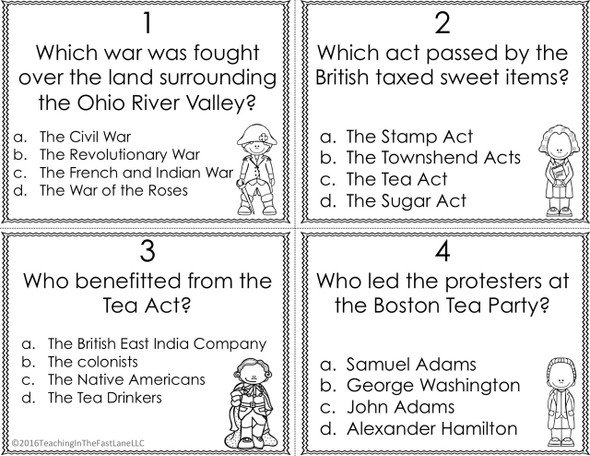Description
This PowerPoint Lesson (51 slides) Includes:
- Learning intentions
- Essential Question: How did power shift in North America after the French and Indian War?
- Brief warm up review of colonial America
- Causes of the French and Indian War
- George Washington's youth
- Fort Necessity
- Albany Plan of Union
- Early British losses
- William Pitt
- General Wolfe takes Quebec
- The Treaty of Paris (1763)
- Effects of the war
- Pontiac's War
- The Proclamation of 1763
- Daniel Boone
- Cooperative learning activity/discussion
Learning Objectives:
- Explain how the rivalry between Britain and France over the Ohio Valley led to the French and Indian War in North America
- Identify how mistakes and a lack of unity led to early defeats for the British in the war
- Summarize how the tide of the war turned in Britain’s favor
- Explain how the British won the war
- Describe the power shift that occurred after the war
- Explain how Britain attempted to ease tensions with the Proclamation of 1763
Please Note:
- PowerPoints need to have their content enabled before presenting
- Videos and music are included in the PowerPoint--> LOOK FOR THE CAMERA AND BOOMBOX ICON & CLICK!
- The Modern Love (Headings), Roboto, and Avenir Next LT Pro are the primary fonts used in this presentation. You may need to adjust the font/size if you do not have a version of PowerPoint that includes these fonts.
_________________________________________________________________
French and Indian Resource Set (19 pages):
- Vocabulary chart
- Cornell style notes
- Map activity
- Q&A for the French and Indian War
- Political cartoon analysis
- Pros and cons list for the Albany Plan of Union (1754)
- Pros and cons list for the Proclamation of 1763
- 3 different causes and effects charts (1 complete-key, 1 completely blank, 1 that is half-filled for students to complete)
- 6 writing prompts
Learning Objectives:
- Explain how the rivalry between Britain and France over the Ohio Valley led to the French and Indian War in North America
- Identify how mistakes and a lack of unity led to early defeats for the British in the war
- Summarize how the tide of the war turned in Britain’s favor
- Explain how the British won the war
- Describe the power shift that occurred after the war
- Explain how Britain attempted to ease tensions with the Proclamation of 1763
_______________________________________________________________
This Editable Revolutionary War PowerPoint (over 200 slides) Covers:
- Causes of the American Revolution
- Review of the French and Indian War
- Mercantilism and taxation
- The Sugar Act (1764)
- The Stamp Act (1765)
- The Quartering Act (1765)
- "No taxation without representation"
- The Townshend Acts (1767)
- The Boston Massacre (1770)
- The Tea Act (1773)
- The Intolerable Acts (1774)
- Minutemen
- First and Second Continental Congress
- Battles of Lexington and Concord
- George Washington, King George III, Samuel Adams, John Adams, Abigail Adams, Mercy Otis Warren, Patrick Henry, Ethan Allen, Thomas Paine, Thomas Jefferson, Nathan Hale, Haym solomon, General Charles Cornwallis, Marquis de Lafayette, Friedrich von Steuben, James Armistead, Wentworth Cheswell, Bernardo de Galvez, Captain John Paul Jones, Benedict Arnold, and more!
- Concord Hymn by Ralph Waldo Emerson (1837)
- Patriots vs. Loyalists
- Continental Army
- Battle of Bunker Hill
- Declaration of Independence
- Comparing Continental and British forces
- Battle of Trenton
- Battle of Princeton
- Battle of Saratoga
- European aid and allies
- Valley Forge
- Women in the war
- African Americans in the war
- Spanish and Native Americans' roles in the war
- Battle of Yorktown
- Treaty of Paris (1783)
- Cooperative learning activity/discussions throughout the PPT
- Pop quizzes with potential test questions throughout the PPT
- Links to videos throughout the PPT
- Venn diagram-comparison activity
- Map analysis
- Quote analysis
- Music analysis
Learning Objectives / TEKS:
- 8.4.A analyze causes of the American Revolution, including the Proclamation of 1763, the Intolerable Acts, the Stamp Act, mercantilism, lack of representation in Parliament, and British economic policies following the French and Indian War
- 8.4.C explain the issues surrounding important events of the American Revolution, including declaring independence; fighting the battles of Lexington, Concord, Saratoga, and Yorktown; enduring the winter at Valley Forge; and signing the Treaty of Paris of 1783
- explain the roles played by significant individuals during the American Revolution, including Abigail Adams, John Adams, Wentworth Cheswell, Samuel Adams, Mercy Otis Warren, James Armistead, Benjamin Franklin, Bernardo de Gálvez, Crispus Attucks, King George III, Haym Salomon, Patrick Henry, Thomas Jefferson, the Marquis de Lafayette, Thomas Paine, and George Washington
- 8.10.C analyze the effects of physical and human geographic factors on major historical and contemporary events in the United States
- 8.11.A analyze how physical characteristics of the environment influenced population distribution, settlement patterns, and economic activities in the United States during the 17th, 18th, and 19th centuries
- 8.23.E identify the political, social, and economic contributions of women to American society
- 8.26.B identify examples of American art, music, and literature that reflect society in different eras
- 8.15.C identify colonial grievances listed in the Declaration of Independence
- 8.20.B analyze reasons for and the impact of selected examples of civil disobedience in U.S. history such as the Boston Tea Party
Please Note:
- PowerPoint needs to have the content enabled before presenting
- Videos and music are included in the PowerPoint--> LOOK FOR THE VIDEO CAMERA AND BOOMBOX ICON & CLICK!
- The Modern Love (Headings), Roboto, and Avenir Next LT Pro are the primary fonts used in this presentation. You may need to adjust the font/size if you do not have a version of PowerPoint that includes these fonts
_______________________________________________________________
Resource Set...
This 100 PAGE resource set for the American Revolution includes: Cornell-style notes organizers, map activities, profiles of important figures, writing prompts, a game guide for a digital simulation game over the causes of the American Revolution, webquests, projects, and more!
This set has assignments and/or note guides that cover:
- Causes of the American Revolution
- Review of the French and Indian War
- Mercantilism and taxation
- The Sugar Act (1764)
- The Stamp Act (1765)
- The Quartering Act (1765)
- "No taxation without representation"
- The Townshend Acts (1767)
- The Boston Massacre (1770)
- The Tea Act (1773)
- The Intolerable Acts (1774)
- Minutemen
- First and Second Continental Congress
- Battles of Lexington and Concord
- George Washington, King George III, Samuel Adams, John Adams, Abigail Adams, Mercy Otis Warren, Patrick Henry, Ethan Allen, Thomas Paine, Thomas Jefferson, Nathan Hale, Haym solomon, General Charles Cornwallis, Marquis de Lafayette, Friedrich von Steuben, James Armistead, Wentworth Cheswell, Bernardo de Galvez, Captain John Paul Jones, Benedict Arnold, and more!
- Concord Hymn by Ralph Waldo Emerson (1837)
- Patriots vs. Loyalists
- Continental Army
- Battle of Bunker Hill
- Declaration of Independence
- Comparing Continental and British forces
- Battle of Trenton
- Battle of Princeton
- Battle of Saratoga
- European aid and allies
- Valley Forge
- Women in the war
- African Americans in the war
- Spanish and Native Americans' roles in the war
- Battle of Yorktown
- Treaty of Paris (1783)
Learning Objectives / TEKS:
- 8.4.A analyze causes of the American Revolution, including the Proclamation of 1763, the Intolerable Acts, the Stamp Act, mercantilism, lack of representation in Parliament, and British economic policies following the French and Indian War
- 8.4.C explain the issues surrounding important events of the American Revolution, including declaring independence; fighting the battles of Lexington, Concord, Saratoga, and Yorktown; enduring the winter at Valley Forge; and signing the Treaty of Paris of 1783
- explain the roles played by significant individuals during the American Revolution, including Abigail Adams, John Adams, Wentworth Cheswell, Samuel Adams, Mercy Otis Warren, James Armistead, Benjamin Franklin, Bernardo de Gálvez, Crispus Attucks, King George III, Haym Salomon, Patrick Henry, Thomas Jefferson, the Marquis de Lafayette, Thomas Paine, and George Washington
- 8.10.C analyze the effects of physical and human geographic factors on major historical and contemporary events in the United States
- 8.11.A analyze how physical characteristics of the environment influenced population distribution, settlement patterns, and economic activities in the United States during the 17th, 18th, and 19th centuries
- 8.23.E identify the political, social, and economic contributions of women to American society
- 8.26.B identify examples of American art, music, and literature that reflect society in different eras
- 8.15.C identify colonial grievances listed in the Declaration of Independence
- 8.20.B analyze reasons for and the impact of selected examples of civil disobedience in U.S. history such as the Boston Tea Party














































